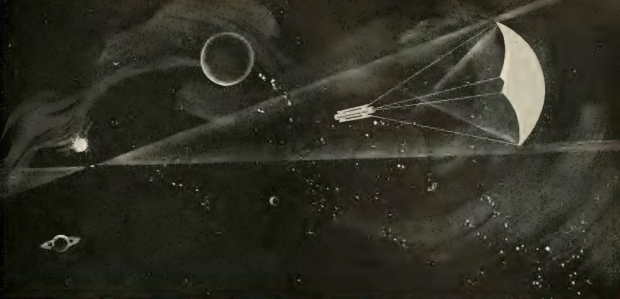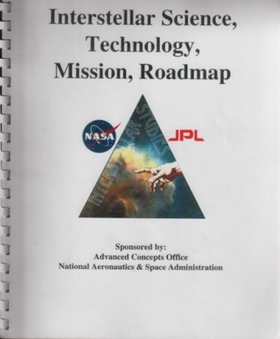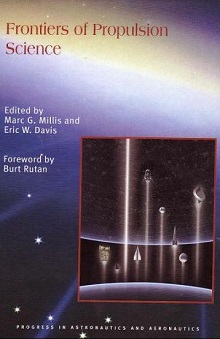The idea of beaming a propulsive force to a sail in space is now sixty years old, if we take Robert Forward’s first publications on it into account. The gigantic mass ratios necessary to build a rocket that could reach interstellar distances were the driver of Forward’s imagination, as he realized in 1962 that the only way to make an interstellar spacecraft was to separate the energy source and the reaction mass from the vehicle.
Robert Bussard knew that as well, which is why in more or less the same timeframe we got his paper on the interstellar ramjet. It would scoop up hydrogen between the stars and subject it to fusion. But the Bussard ramjet had to light fusion onboard, whereas a sail propelled by a laser beam – a lightsail – operated without a heavy engine. The idea worked on paper but demanded a laser of sufficient size (Forward calculated over 10 kilometers) to make it a concept for the far future. His solution demanded very large lasers in close solar orbits, and thus an existing system-wide space infrastructure.
Forward’s article “Pluto – Gateway to the Stars” ran in the journal Missiles and Rockets in April of 1962 (and would later be confused with an article having a similar name that ran in Galaxy that year, though without the laser sail concept). The beauty of the laser sail was immediately apparent, one of those insights that have other theorists asking themselves why they hadn’t come up with it. Because a beamed sail greatly eases the inverse square law problem. The latter tells us that solar photons aren’t enough because they decrease with the square of our distance from the Sun. Make your laser powerful enough and its narrow beam can push much harder and further.

Image: This is the original image from the Missiles and Rockets article. Caption: Theoretical method for providing power for interstellar travel is use of a very large Laser in orbit close to sun. Laser would convert random solar energy into intense, very narrow light beams that would apply radiation pressure to solar sail carrying space cabin at distances of light years. Rearward beam from Laser would equalize light pressure. Author Forward observes, however, that the Laser would have to be over 10 kilometers in diameter. Therefore other means must be developed.
All the work that began with Forward’s initial sail insights had been theoretical, with authors exploring laser concepts of varying sizes and shapes even as Forward offered fantastic mission designs that could take human crews to places like Epsilon Eridani while obeying the laws of physics. He believed a mission to Alpha Centauri could be launched as early as 1995, triggering interest from JPL’s Bruce Murray, who convened a workshop in 1980 to quantify Forward’s notions and find ways to return a payload to Earth. To my knowledge, the papers from this workshop have never been published, doubtless because the engineering demanded by such a mission was far beyond our reach. Still, it would be interesting to read the thoughts of workshop luminaries Freeman Dyson, Forward, Bussard and others on where we stood in that timeframe.

In 1999 NASA’s Advanced Concepts Office proposed a launch to Alpha Centauri in 2028, a notion that might have been furthered by Jim Benford and Geoffrey Landis’ proposal of using a carbon micro-truss (just invented in that year) that could withstand a microwave beam without melting. Now we begin to see actual laboratory experiments, and in the same year Leik Myrabo subjected carbon micro-truss material to laser beam bombardment to measure an acceleration of 0.15 gravities. See Benford’s A Photon Beam Propulsion Timeline for more on this period of sail laboratory work.
Image: Plan for the development of sails for interstellar flight, 1999. Credit: JPL/Caltech.
So laboratory work explicitly devoted to microwave- and laser-driven sails began 25 years ago and has lately resurfaced through work on sail materials that has developed through the Breakthrough Starshot initiative. Indeed, there are numerous recent papers scattered through the literature that we will be discussing in the future, some containing experimental results from Starshot-funded scientists. It would be helpful for the entire community if this work could be codified and presented in a single report.
But let’s go back to that early lab work. It was in April of 2000 that Benford showed, in experiments at JPL, that sails driven by a microwave beam could survive accelerations up to 13 gravities, while undergoing desorption when the sail reached high temperatures (desorption could have interesting propulsive effects of its own). The effects of spinning the sail were also examined, while Myrabo’s team in that same year experimented with carbon sails coated with molybdenum. By 2002, Benford and his brother Gregory demonstrated in work at UC-Irvine that a conical sail could be stable while riding a microwave beam.
While further work at the University of New Mexico under Chaouki Abdallah and team developed simulations confirming the stability of conical sails under a microwave beam, interest in sails primarily focused on materials in the work of scientists like Gregory Matloff and Geoffrey Landis. Landis’ work on dielectric films for highly reflective sails was particularly significant as materials science kept coming up with interesting candidates — Matloff proposed graphene as a sail material that can sustain high accelerations in 2012, and the examination of metamaterials for the task continues.
When Philip Lubin’s team at UC-Santa Barbara began their work on small wafer-sized spacecraft, it would feed into the concept of the Breakthrough Starshot initiative that was announced in 2016 (See Breakthrough Starshot: Early Testing of ‘Wafer-craft’ Design). Lubin’s work in turn grew out of the Project Starlight and DEEP-IN beamed energy studies his team pursued at UC-Santa Barbara, work that has now been collected in a two-volume set called The Path to Transformational Space Exploration.
A spacecraft on a chip can itself be a micro-sail, as Mason Peck (Cornell University) and team have pointed out in their examination of chips that could use solar photon pressure to move about the Solar System (see Beaming ‘Wafer’ Probes to the Stars). So the idea of miniaturizing a payload and exploiting the potential of laser beaming grafts readily onto the microchip research already underway. It’s interesting that the idea of incorporating the payload into the sail itself goes back to Robert Forward’s Starwisp concept, a kind of ‘smartsail’ whose surface contains the circuits that acquire data. Unfortunately, the Starwisp design had serious flaws, as Geoff Landis would later point out.
We’re still in the early stages in terms of laboratory work focused on sail materials for a lightsail that could carry any kind of payload. Let me quote an interesting new paper on this matter:
Most of the work discussed so far has been theoretical and numerical. Experimental verification of many aspects of lightsails, such as deployment and stability, are difficult to achieve in laboratories subject to Earth’s gravity, and may require extremely powerful lasers and extreme vacuum chambers. Many of the proposed structures are not yet able to be fabricated on the scales required, or rely on material properties that are insufficiently characterized.38 Thus, before full sails can be made, let alone tested, it is imperative that experimental characterizations that can be achieved on Earth be conducted.
This is from a paper by Jadon Lin (University of Sydney) and colleagues called “Photonic lightsails: Fast and Stable Propulsion for Interstellar Travel,” a preprint available here (thanks to Michael Fidler for the reference). We need to talk about the kind of tests needed, and I’ll begin with that next time. We’re headed for the interesting work performed at JPL under Harry Atwater that grows out of a concept some consider our best chance for reaching another star in this century.



Simulations are nice, but they do not beat actual material objects. I recall the video of the Benfords’ microwave-propelled graphite (?) sails.
Just how expensive would an actual space-based test be? I imagine a lightweight structure to contain the sail to prevent it from escaping and interfering with satellites. The structure would have an array of tiny, cheap, fiberoptic-guided lasers. The sail[s] would be shaped based on the simulation results. The flight stability would be recorded by sensors/cameras. The experiment would be carried out at the ISS or free-flying with micro-g and vacuum as required to test a small deployed sail in space. The test rig, if at the ISS, could be used to test various types of sail material which would be sent to the ISS with each crew rotation. The sails themselves would be of negligible mass, although perhaps housed and deployed in some cartridge that could be inserted into the structure for the test.
The purpose would be to test the stability and dynamics of a beamed sail as a first step to deploying larger sails. [I don’t recall if the proposed microwave beaming of the Planetary Society’s sail was ever carried out.] The proposed ground-based lasers were to be placed in Chile’s Atacama desert plateau where the thin, dry atmosphere would have the least impact on the laser beam directed at an orbiting sail. While large, ground-based, phased laser arrays are cost-effective for a variety of tasks, it seems likely that for interstellar missions with larger sails, space-based laser arrays would be more desirable, whether free flying or based on a surface such as the Moon or Mercury. Whether these off-planet laser arrays can be built in this century or the next would depend on cost and usefulness, both for interstellar beamed sails and for other purposes such as planetary defense that Lubin was pushing for.
I think the future is going to be something along the lines of McCulloch’s Quantized Inertia or Woodward’s MEGA drive or Buhler’s Electrostatic propulsion where no reaction mass is required. Alternatively, the universe is the reaction mass and the ship only supplies energy to accelerate. Much further out are Woodward’s and Jack Sarfatti’s warp drive ideas. I hope something along those lines turns out to be true.
Thank you for the tip on Harry Atwater. I found several articles on the testing of the “miniature trampoline,” a tiny lightsail tethered at the corners for direct radiation pressure measurement.
The Pressure to Explore: Caltech Researchers Take First Experimental Steps Toward Lightsails that Could Reach Distant Star Systems.
https://www.caltech.edu/about/news/the-pressure-to-explore-caltech-researchers-take-first-experimental-steps-toward-lightsails-that-could-reach-distant-star-systems
From Sci-Fi to Reality: Laser-Powered Sails Are Changing the Future of Space Travel.
https://scitechdaily.com/from-sci-fi-to-reality-laser-powered-sails-are-changing-the-future-of-space-travel
A well-produced video on Harry Atwater’s research titled “Starshot: From Science to Spacecraft and Missions.”
https://www.youtube.com/watch?v=jV2sNOYzaFA
An interesting article relating to the technology behind the lightsail project, which has DARPA funding.
Science & Technology February 26, 2025
The future of telescope lenses is flat
U engineers create first flat telescope lens that can capture color while detecting light from faraway stars.
https://attheu.utah.edu/science-technology/the-future-of-telescope-lenses-is-flat/
There is a ribbon sail proposed
https://www.universetoday.com/171143/a-giant-ribbon-can-pull-payloads-along/
Dark Energy from the tachocline?
https://www.cam.ac.uk/research/news/have-we-detected-dark-energy-cambridge-scientists-say-its-a-possibility
@Jeff
I had a similar concept in which a ribbon was on two rollers which wound itself out to form a long ribbon. Once at full extension the ribbon was opened at the sun facing side allowing solar radiation into open it up. Eventually it acted as a light parachute and allowed us to approach the sun very closely to have maximum effect.
Paul: You might point out explicitly that those 2000 experiments of mine were the first of the essential element of beamed propulsion, flights of sails in a vacuum chamber.
Stability experiments don’t need “extremely powerful lasers and extreme vacuum chambers”. We used a 10 kW klystron microwave source pulsed for 0.2 sec. The base pressure for the chamber is 2 e 10-7 Torr, which is ~ ten to the minus 10 atmospheres. That’s quite low, but well within vacuum technologies for almost a century.
Alex Tolley: It was a new material, carbon micro-truss, a truss structure made of short discontinuous discrete carbon fiber with the sandwich facings, a 2-D net of long discontinuous discrete carbon fibers.
You ask if the microwave beaming of the Planetary Society’s sail was carried out. The sail was launched, but did not reach orbit. We were ready to use the big Goldstone Deep Space Network beam to accelerate it in orbit. That’s described in “MAX-Microwave Acceleration eXperiment with Cosmos-1”, James Benford, Gregory Benford and Tom Kuiper, JBIS, 59, 68, (2006)
There is a pretty good bibliography of related sale papers at the CalTech lightsail site here:
https://www.lightsail.caltech.edu/publications
Jim